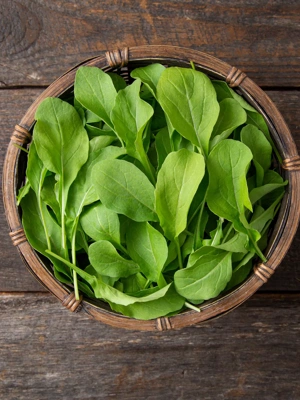Arugula

Arugula is a salad green also sold as rocket or by its French name, roquette. This member of the mustard family is truly a rocket: it germinates quickly — even in cold, wet soil — and grows rapidly. Full-sized plants are often ready to eat just a month after germination.
Arugula is an acquired taste. It has a smoky, peppery, complex flavor and scent that some even call skunky. To begin appreciating arugula's distinctive flavor, start by adding little pieces of leaves to regular salads. Before long you'll probably find yourself adding more and more leaves, and may eventually want nothing but arugula in your salads!
 Arugula growing in a raised bed
Arugula growing in a raised bedThere are a number of different types of arugula. In general, the thinner and spikier the leaves, the more peppery the flavor. Start arugula from seed outdoors directly in the garden as soon as the soil can be worked. Plant it just a quarter of an inch deep, covering it with a light layer of fine soil. Arugula is not fussy—it is only a slightly modified weed—so it will grow in most soils. It does best in rich soil with plenty of organic matter, and has its best flavor when it is not stressed by heat or lack of water.
Once summer arrives, arugula leaves quickly turn bitter and the plant shifts into flower production. When this happens, it's time to remove the plants and sow a new crop. Like most greens, it's difficult to grow arugula during the heat of summer. To maintain a continuous supply of young, tender leaves, sow a pinch of seeds somewhere in the garden every two or three weeks throughout the growing season. In late summer, sowing arugula under shade cloth will let you get plants established for a fall harvest. When cold weather comes, just cover the bed with Garden Quilt to get another month or more of good salads. In warmer zones, arugula can usually be grown as a winter crop without cover.
Flea beetles love to munch arugula, and can severely damage the leaves. Garden fabric (row cover) is the most effective solution.
Because arugula plants are relatively small and have compact root systems, you can plant them close together, or even in a pot. As leafy greens they have less need for full sun and will even grow in partial shade or where tall plants create shade. In hot regions afternoon shade is better than full sun, as the plants will not bolt as quickly.
Last updated: 01/28/2021
Print this Article:
Related items
Get the Dirt
Stay up to date on new articles and advice. Please fill out the information below.





